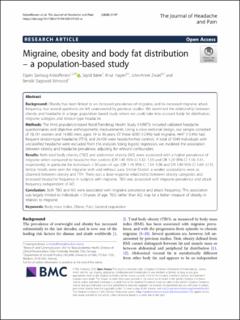Migraine, obesity and body fat distribution - a population-based study
Peer reviewed, Journal article
Published version
Permanent lenke
https://hdl.handle.net/11250/2673362Utgivelsesdato
2020Metadata
Vis full innførselSamlinger
Originalversjon
https://doi.org/10.1186/s10194-020-01163-wSammendrag
Background: Obesity has been linked to an increased prevalence of migraine, and to increased migraine attack frequency, but several questions are left unanswered by previous studies. We examined the relationship between obesity and headache in a large, population-based study where we could take into account body fat distribution, migraine subtypes and tension-type headache.
Methods: The third population-based Nord-Trøndelag Health Study (HUNT3) included validated headache questionnaires and objective anthropometric measurements. Using a cross-sectional design, our sample consisted of 18,191 women and 14,985 men, aged 19 to 96 years. Of these 4290 (12.9%) had migraine, 4447 (13.4%) had frequent tension-type headache (TTH), and 24,439 were headache-free controls. A total of 5049 individuals with unclassified headache were excluded from the analyses. Using logistic regression, we modeled the association between obesity and headache prevalence, adjusting for relevant confounders.
Results: Both total body obesity (TBO) and abdominal obesity (AO) were associated with a higher prevalence of migraine when compared to headache-free controls (OR 1.45 95% CI 1.32–1.59 and OR 1.29 95% CI 1.18–1.41, respectively), in particular for individuals < 50 years of age (OR 1.74 95% CI 1.54–1.98 and OR 1.89 95% CI 1.69–2.11). Similar results were seen for migraine with and without aura. Similar Overall, a weaker associations were as observed between obesity and TTH. There was a dose-response relationship between obesity categories and increased headache frequency in subjects with migraine. TBO was associated with migraine prevalence and attack frequency independent of AO.
Conclusion: Both TBO and AO were associated with migraine prevalence and attack frequency. This association was largely limited to individuals < 50 years of age. TBO, rather than AO, may be a better measure of obesity in relation to migraine.

